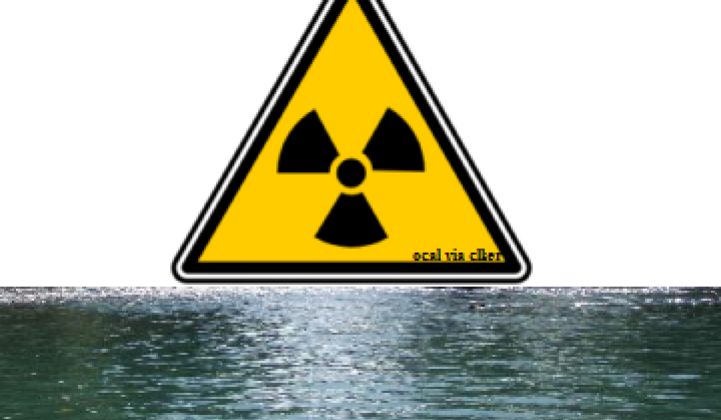The opportunity in uranium could still be very big, despite the Fukushima furor. Or it could flow away like water.
“The market that has not changed, post-Fukushima, is the emerging market,” said Amir Adnani, President, CEO and Director of Uranium Energy Corp (UEC). “Sixty-two reactors are under construction. That was the number before Japan, and it’s still the number.”
Growth, Adnani added, is unlikely to be stymied by short-lived controversy. “It is in China, it’s in South Korea, it’s in India, it’s in Russia. In those countries, the nuclear industry is a government-run industry.” Such governments remain enthusiastic about nuclear power’s emissions-free scale.
At present, Adnani said, “demand in the U.S. is 55 million pounds per year; on a worldwide basis, it's 175 million pounds per year.” At the same time, “on a worldwide basis, the industry only mines 120 million pounds.”
The balance has been met by stored supplies and materials recovered under a U.S.-Russia weapons recycling agreement that expires in 2013. “In any commodity business, when you consume more than you produce,” Adnani said, “you’re going to end up seeing higher prices for that commodity” and, ultimately, “an expansion of mine production.”
But it may not, according to Christopher Paine, the Nuclear Program Director of the Natural Resources Defense Council (NRDC), be quite as ripe a market as Adnani described. “His basic premise -- that there’s going to be this huge shortage of uranium and the price is going to go sky high and he’s going to cash in -- is questionable," Paine said. "There is a lot of capacity that’s being constructed in China, but there’s capacity in Europe that looks like it’s going to be coming off-line. There are even reactors in the U.S. that look like they’re going to be shutting down.”
In addition, Paine added, “The bulk of the market is tied up in long-term contracts.” It is dominated by major players such as Cameco, Mestena and Uranium One. UEC may, Paine said, be able to effectively play the spot market, which is about 15 percent to 20 percent of overall demand, but historically low prices have made him dubious about the potential efficacy of this gambit.
Adnani does not share his skepticism. The spot market price is, he pointed out, $56 per pound, well over his present $18-per-pound cash operating expense. He also contended that a lot of contract potential exists after 2013 and as world demand rises with plants in emerging economies coming on-line.
“I am an entrepreneur with a natural resource background,” Adnani said. Six years ago, there was a dramatic proliferation of U.S. companies, perhaps as many as 500, he explained, that aspired to engage in uranium mining. Today, UEC is one of the few left and the only one in production.
It is, Adnani said, “an incredibly small space. But it’s an incredibly important sector for power generation. To me, that’s a unique opportunity.” Much of UEC’s activity is in South Texas, where it is pursuing ore deposits largely identified during oil and gas exploration during the 1970s and 1980s.
One of the keys to UEC’s success is its people, Adnani said. “We have a team of people who have been there, done that. They built 80 percent of the In-Situ Recovery (ISR) projects ever built in the U.S.,” he explained. Plus, he added, “Texas is an incredibly energy-friendly and business-friendly state to operate in.”
UEC’s Palangana ISR project began producing last November. It came pre-permitted with UEC’s purchase of an adjacent plant where mined uranium is processed into yellowcake. The company has not found Texas to be as friendly at its Goliad project site, where the cutting-edge ISR technology has met hard resistance.
“We’re in our fifth year of fighting this,” said Raulie Irwin, Board Member and Chairman of the Uranium Committee of the Goliad County Groundwater Conservation District. “When they started, they didn’t notify anybody in the county. They got a permit from the Railroad Commission, an exploratory permit, and they went out there and started drilling.”
Adnani explained that county permission wasn’t required because the test wells were drilled on leased private property.
"We did get the Railroad Commission to come out and pull an inspection when they were drilling all their holes out there,” Irwin said. “They cited them with 134 violations.”
Both Goliad County and the Conservation District contend that ISR will be ruinous to drought-plagued Goliad’s Evangeline aquifer, the single water source from which all its wells flow.
Adnani explained that UEC had met all environmental and legal obligations for disclosure and had been authorized to mine by Texas Commission on Environmental Quality (TCEQ) geologists and hydrologists. Goliad County brought a battery of distinguished geologists and hydrologists who concluded that ISR would be a threat to the aquifer.
The only thing now between UEC and uranium mining in Goliad County is the Safe Drinking Water Act. It requires that groundwater at mined sites be restored to its pre-mining quality.
Adnani said water samples taken immediately adjacent to uranium sands will inevitably have uranium and radon in them, releasing UEC from the responsibility to restore the water to drinking quality. Goliad County’s position is that their water, even at the sites UEC wants to mine, was clean and being safely used until UEC started exploration drilling. The granting to UEC by EPA of the final permission to proceed will hinge largely on this question.
Numerous uranium market analysts, little concerned with environmental controversies, rate UEC very highly.



